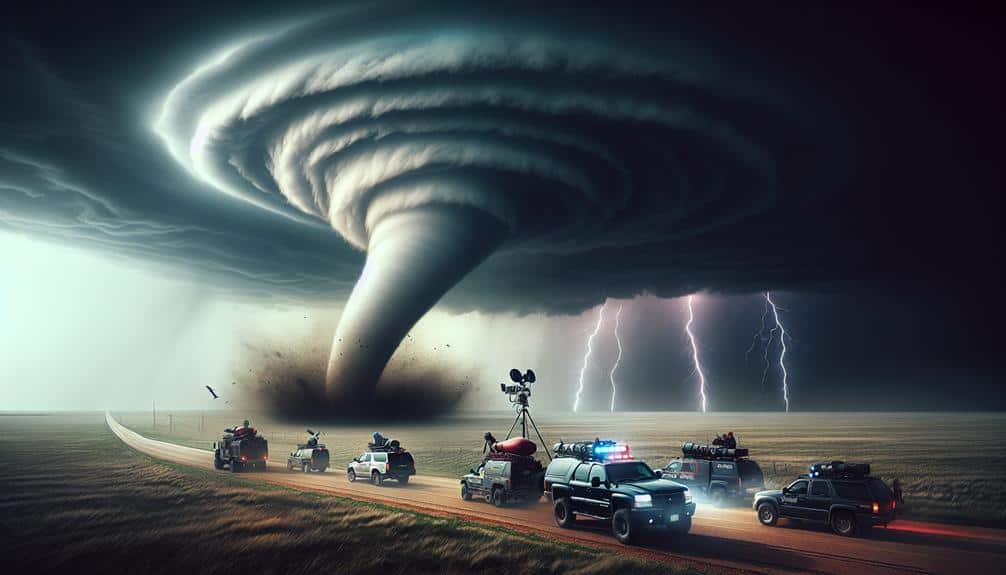For storm chasing competition success, we must start with thorough analysis of historical and current weather patterns using tools like satellite imagery and Doppler radar. Selecting high-quality cameras, water-resistant cases, and dependable GPS units enhances our equipment readiness. Our safety plan should incorporate emergency procedures and live weather monitoring to guarantee a prompt and secure response to any situation. Building a team with diverse skills and fostering strong communication is essential. To wrap up, practicing decision-making through risk assessments and simulated routes hones our ability to make prompt, well-informed choices. There's a lot more to master in storm chasing.
Key Points
- Analyze historical and real-time weather data to identify storm patterns and trends.
- Equip vehicles with high-resolution cameras, waterproof cases, and reliable GPS units.
- Develop a robust safety plan with emergency protocols and real-time weather tracking.
- Build a skilled team with diverse expertise and strong communication skills.
Research Weather Patterns
To successfully engage in storm chasing competitions, we must carefully analyze historical and real-time weather patterns. Our journey begins with a detailed meteorological analysis, where we explore past storm data to identify patterns and trends. By examining historical records, we pinpoint regions with high storm activity, giving us a strategic advantage in storm prediction.
We rely on advanced meteorological tools and models to interpret data from sources like satellite imagery, Doppler radar, and weather balloons. These instruments provide us with vital information on atmospheric conditions, such as humidity, temperature, and wind speed. Real-time data feeds allow us to track storm development with accuracy, offering insights into potential storm paths and intensities.
Storm prediction hinges on understanding the complex dynamics of weather systems. We use numerical weather prediction models to simulate atmospheric behavior, enabling us to forecast storm occurrences with greater precision. By cross-referencing these models with real-time observations, we refine our predictions, enhancing our ability to anticipate storm movements.
Our analytical approach empowers us to make informed decisions, maximizing our chances of encountering significant weather events. This thorough preparation is essential for success in storm chasing competitions, where every moment counts and the freedom to roam depends on our predictive prowess.
Choose the Right Equipment
Equipped with robust weather predictions, we now turn our attention to selecting the best gear necessary for effective storm chasing. Our first priority is camera gear. High-resolution DSLR cameras, equipped with wide-angle lenses and fast shutter speeds, allow us to capture detailed storm structures and lightning. Tripods are indispensable for stability, especially during long exposure shots. Investing in waterproof cases guarantees our equipment remains functional even in adverse conditions.
Equally critical are our navigation tools. Reliable GPS units with real-time traffic and weather updates are essential. We should consider models that offer offline maps to maintain functionality in areas with limited connectivity. Integrating these with radar applications on our smartphones provides an added layer of situational awareness. A quality dashcam can also serve dual purposes: documenting our journey and providing additional data for post-chase analysis.
We must also make sure our vehicles are equipped with all-terrain tires and that we carry essential repair kits. Every piece of equipment we choose should contribute towards efficiency and safety. By leveraging advanced camera gear and navigation tools, we enhance our ability to document and analyze storms, making each chase not just an adventure, but a data-driven pursuit.
Develop a Safety Plan
Creating a comprehensive safety plan is crucial for mitigating risks and safeguarding the well-being of all team members during storm chasing expeditions. We need to establish emergency protocols that cover various scenarios, including severe weather changes and unexpected equipment failures. Our communication strategy should be robust, employing multiple channels (radios, mobile devices, etc.) to maintain constant contact. Clear, predefined signals for emergencies and regular updates will guarantee that everyone remains informed and connected.
Weather tracking is a vital component of our safety plan. We'll utilize real-time data from reliable sources like the National Weather Service and advanced radar systems. This data-driven approach allows us to anticipate storm movements and make informed decisions. Additionally, we should have pre-determined evacuation routes mapped out for each area we plan to chase in. These routes need to be evaluated for accessibility and safety, guaranteeing swift exits if conditions worsen unexpectedly.
Our goal is to balance the excitement of storm chasing with rigorous safety measures. By incorporating emergency protocols, a solid communication strategy, meticulous weather tracking, and well-planned evacuation routes, we can maximize both our freedom and safety during these high-stakes adventures.
Build a Skilled Team
Building an effective storm chasing team requires a meticulous selection process focused on individual expertise, experience, and collaborative skills. We need members who bring meteorological knowledge, technical proficiency, and practical field experience. By combining diverse skill sets, we guarantee thorough data analysis and robust operational efficiency.
Team dynamics are crucial to our success. We must assess potential members not just on their individual capabilities, but also on their ability to work cohesively. It's essential to foster an environment where each member's strengths are leveraged while minimizing any weaknesses. For instance, pairing a seasoned meteorologist with a technologically adept individual enhances both predictive accuracy and data acquisition.
Effective communication strategies form the backbone of our operations. Clear, concise, and timely communication guarantees that everyone is on the same page, especially during high-stress situations. Utilizing structured briefings, real-time updates, and debriefs helps streamline our processes. Tools like radios, satellite phones, and data-sharing platforms are indispensable for maintaining seamless communication.
Practice Decision Making

To hone our decision-making skills, we must simulate real-world scenarios where rapid and accurate judgments are crucial. We can achieve this by engaging in rigorous risk assessment exercises, analyzing storm patterns, and predicting potential hazards. By incorporating historical weather data, we can identify trends and anomalies, allowing us to refine our judgment in high-pressure situations.
Strategic planning is essential in these simulations. We should map out various storm-chasing routes, considering factors such as road conditions, escape routes, and proximity to potential storm cells. Evaluating these elements systematically helps us prioritize safety while maximizing our storm-chasing efficiency.
We also need to practice making split-second decisions, such as when to reposition or when to deploy instruments, making sure our actions are both calculated and swift.
Data-driven approaches enhance our decision-making. By integrating real-time data feeds, such as radar and satellite imagery, we can stay informed and adapt our strategies on the fly. Utilizing advanced software for predictive modeling further sharpens our ability to anticipate storm behavior and make informed choices.
Ultimately, our freedom in the field hinges on our preparedness. Practicing decision-making in controlled environments guarantees that, when the time comes, we're ready to face the unpredictability of nature head-on.
Frequently Asked Questions
How Do You Handle Unexpected Mechanical Failures During a Chase?
We handle unexpected mechanical failures by implementing our contingency plans immediately. We carry essential tools, spare parts, and diagnostic equipment. By analyzing the issue on-site, we quickly determine the best course of action to minimize downtime.
What Are the Best Apps for Real-Time Storm Tracking?
When it rains, it pours; for real-time storm tracking, we rely on apps like RadarScope for precise weather radar and My Lightning Tracker for instant lightning alerts. These tools provide the freedom to anticipate and respond swiftly.
We can enhance our navigation skills by mastering navigation techniques, combining GPS technology with topographic maps, and honing weather forecasting abilities. This guarantees we're precisely positioned to track storms effectively, enhancing our freedom to chase safely and successfully.
What Should You Pack for a Multi-Day Storm Chasing Trip?
'Better safe than sorry!' For a multi-day storm chasing trip, we should pack emergency supplies, clothing, camera equipment, and snacks. Prioritize durable gear, weather-appropriate attire, high-quality cameras, and non-perishable food to guarantee preparedness and freedom.
How Do You Stay Motivated During Long Periods Without Storm Activity?
We stay motivated during long periods without storm activity by building mental resilience through self-care. Engaging in hobby distractions and maintaining exercise routines also help us recharge, ensuring we're ready for the next chase with renewed energy.


